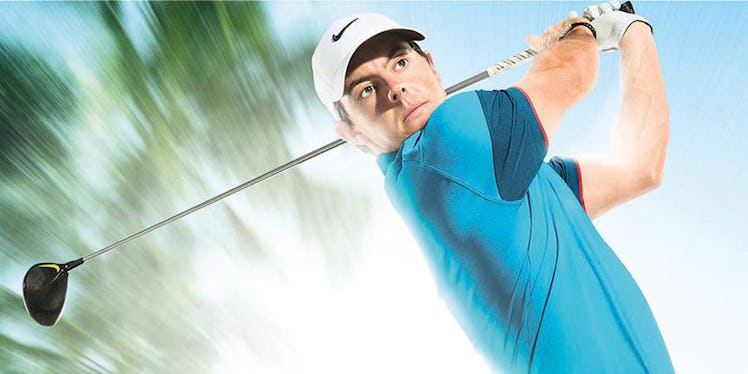The 2015 PGA season has begun, and as the snow finally melts in the Northeast, enthusiasts drag their clubs out of the garage and begin to look forward to those four pristine days in April.
The focus of sports will shift to Augusta, Georgia and the hallowed tradition of the Masters Tournament.
A stern challenge of skill and nerves awaits the world’s best, cloaked in Southern gentility and picturesque scenery. For the first time in nearly two decades, fans will not go home and pop in the EA Sports Golf video game with Tiger Woods on the cover.
Rory McIlroy will grace the cover as he seeks to complete his own career grand slam with a win in Augusta this year and his first green jacket. This shows a shift in the game’s hierarchy and a return to precise gambles over brute force.
Technically, this isn’t the first time McIlroy has been a cover boy for EA Sports. His image was on the 2013 version of the game, but that was only distributed in Europe and still bore the name of Tiger Woods.
This year, he is the name of the game, and certainly earned it after winning two majors and eight individual awards.
When the game drops in June, he may have that green jacket and, perhaps, a second US Open title to his name. Not bad, considering he’s only 25.
Electronic Arts has become the premier production house for a variety of sports games. What started with Madden and NHL Live has become a veritable smorgasbord of titles that cover almost every sport that matters to the American public, from baseball to international soccer to even UFC.
McIlroy has won four majors in his career, but certainly has yet to reach the national recognition his predecessor enjoyed. His face all over the Best Buys and GameStops in America will do a lot for helping raise his Q-level.
Rory’s ascent to dominance comes at a unique time in the game. The sport has sagged a bit since the epic fall from grace of Tiger Woods, the man behind the game’s popular renaissance and power evolution.
Tiger was just that on the course: full of bravado, exuding tremendous energy, hitting shots so darn far they had to lengthen courses.
He brought the television-friendly imagery and visceral reactions of the NFL to golf and fans responded. Traditionalists winced when Tiger swore after a bad shot or gesticulated after a good one.
No one did it his way, and we’ll probably never see another. His body failed him over time, and now, his game is a shade of its former dominance.
He elevated the game and himself to dizzying heights, only to crash like so many before him under the weight of his hubris and self-expectations.
Rory McIlroy is a quieter guy with more conventional play. He rose through the amateur ranks in Northern Ireland and was identified as a star early in life.
He honed his skill for years at home with his dad, and began professional play at the age of 18. He quietly rose through the professional ranks, having a few strong showings at majors before dominating the 2011 US Open with a record score of 16 under.
He struggled in 2013 after changing to Nike equipment, but the deal began to flourish last year with his wins of the last two majors.
Lacking the sheer strength Woods flaunted, McIlroy is more of a traditional golfer. He grew up playing links and other European courses, where skill and risk are favored over massive drives.
Golf can be an unforgiving game with a low tolerance for error (probably why so many people have a love-hate relationship with it as recreational players).
McIlroy plays with precision and avoids mistakes. He sinks his putts and doesn’t play into bad situations where he needs a miraculous bunker save.
At times, it can be boring to watch, but it’s effective. There's no need to be flashy when you’re fundamentally sound.
McIlroy is a great Millennial golfer and an excellent example of the capabilities of our generation. He has that great Irish sense of humor and self-deprecation.
Making his Man U support known after winning the Open in Liverpool drew some boos from the locals, but he was good-natured about it. He makes time to catch his favorite rugby team back home.
He also gained some notoriety for his engagement to Caroline Wozniacki, but ended it when he realized he wasn’t yet ready for marriage.
He took serious consideration for the upcoming Olympics by noting how his Northern Irish nationality would cause consternation.
Next year, if he qualifies, he will do so for Ireland, despite his status as a British subject. He also has done a lot for UNICEF, especially in Haiti, but doesn’t make a big spectacle of it or receive enough attention.
The way he succeeds and conducts himself hearkens back to the the older days of golf when Nicklaus, Palmer and Player dominated with grace and enjoyment of the game.
I’ll tune in next month when he tees up at Augusta to see him pursue that elusive green jacket, as will millions more who are learning about the new face of golf.
